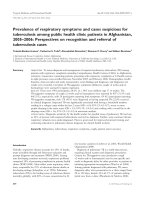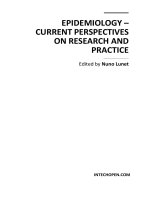Macroeconomic Perspectives on Demand and Supply
Bạn đang xem bản rút gọn của tài liệu. Xem và tải ngay bản đầy đủ của tài liệu tại đây (86.63 KB, 4 trang )
Macroeconomic Perspectives on Demand and Supply
Macroeconomic Perspectives
on Demand and Supply
By:
OpenStaxCollege
Macroeconomists over the last two centuries have often divided into two groups:
those who argue that supply is the most important determinant of the size of the
macroeconomy while demand just tags along, and those who argue that demand is the
most important factor in the size of the macroeconomy while supply just tags along.
Say’s Law and the Macroeconomics of Supply
Those economists who emphasize the role of supply in the macroeconomy often refer
to the work of a famous French economist of the early nineteenth century named
Jean-Baptiste Say (1767–1832). Say’s law is: “Supply creates its own demand.” As a
matter of historical accuracy, it seems clear that Say never actually wrote down this
law and that it oversimplifies his beliefs, but the law lives on as useful shorthand for
summarizing a point of view.
The intuition behind Say’s law is that each time a good or service is produced and sold,
it generates income that is earned for someone: a worker, a manager, an owner, or those
who are workers, managers, and owners at firms that supply inputs along the chain of
production. The forces of supply and demand in individual markets will cause prices to
rise and fall. The bottom line remains, however, that every sale represents income to
someone, and so, Say’s law argues, a given value of supply must create an equivalent
value of demand somewhere else in the economy. Because Jean-Baptiste Say, Adam
Smith, and other economists writing around the turn of the nineteenth century who
discussed this view were known as “classical” economists, modern economists who
generally subscribe to the Say’s law view on the importance of supply for determining
the size of the macroeconomy are called neoclassical economists.
If supply always creates exactly enough demand at the macroeconomic level, then (as
Say himself recognized) it is hard to understand why periods of recession and high
unemployment should ever occur. To be sure, even if total supply always creates an
equal amount of total demand, the economy could still experience a situation of some
firms earning profits while other firms suffer losses. Nevertheless, a recession is not a
1/4
Macroeconomic Perspectives on Demand and Supply
situation where all business failures are exactly counterbalanced by an offsetting number
of successes. A recession is a situation in which the economy as a whole is shrinking in
size, business failures outnumber the remaining success stories, and many firms end up
suffering losses and lying off workers.
Say’s law that supply creates its own demand does seem a good approximation for the
long run. Over periods of some years or decades, as the productive power of an economy
to supply goods and services increases, total demand in the economy grows at roughly
the same pace. However, over shorter time horizons of a few months or even years,
recessions or even depressions occur in which firms, as a group, seem to face a lack of
demand for their products.
Keynes’ Law and the Macroeconomics of Demand
The alternative to Say’s law, with its emphasis on supply, can be named Keynes’ law:
“Demand creates its own supply.” As a matter of historical accuracy, just as JeanBaptiste Say never wrote down anything as simpleminded as Say’s law, John Maynard
Keynes never wrote down Keynes’ law, but the law is a useful simplification that
conveys a certain point of view.
When Keynes wrote his great work The General Theory of Employment, Interest,
and Money during the Great Depression of the 1930s, he pointed out that during the
Depression, the capacity of the economy to supply goods and services had not changed
much. U.S. unemployment rates soared higher than 20% from 1933 to 1935, but the
number of possible workers had not increased or decreased much. Factories were closed
and shuttered, but machinery and equipment had not disappeared. Technologies that
had been invented in the 1920s were not un-invented and forgotten in the 1930s. Thus,
Keynes argued that the Great Depression—and many ordinary recessions as well—were
not caused by a drop in the ability of the economy to supply goods as measured by labor,
physical capital, or technology. He argued the economy often produced less than its full
potential, not because it was technically impossible to produce more with the existing
workers and machines, but because a lack of demand in the economy as a whole led to
inadequate incentives for firms to produce. In such cases, he argued, the level of GDP in
the economy was not primarily determined by the potential of what the economy could
supply, but rather by the amount of total demand.
Keynes’ law seems to apply fairly well in the short run of a few months to a few years,
when many firms experience either a drop in demand for their output during a recession
or so much demand that they have trouble producing enough during an economic
boom. However, demand cannot tell the whole macroeconomic story, either. After all,
if demand was all that mattered at the macroeconomic level, then the government could
make the economy as large as it wanted just by pumping up total demand through
a large increase in the government spending component or by legislating large tax
2/4
Macroeconomic Perspectives on Demand and Supply
cuts to push up the consumption component. Economies do, however, face genuine
limits to how much they can produce, limits determined by the quantity of labor,
physical capital, technology, and the institutional and market structures that bring these
factors of production together. These constraints on what an economy can supply at the
macroeconomic level do not disappear just because of an increase in demand.
Combining Supply and Demand in Macroeconomics
Two insights emerge from this overview of Say’s law with its emphasis on
macroeconomic supply and Keynes’ law with its emphasis on macroeconomic demand.
The first conclusion, which is not exactly a hot news flash, is that an economic approach
focused only on the supply side or only on the demand side can be only a partial success.
Both supply and demand need to be taken into account. The second conclusion is that
since Keynes’ law applies more accurately in the short run and Say’s law applies more
accurately in the long run, the tradeoffs and connections between the three goals of
macroeconomics may be different in the short run and the long run.
Key Concepts and Summary
Neoclassical economists emphasize Say’s law, which holds that supply creates its
own demand. Keynesian economists emphasize Keynes’ law, which holds that demand
creates its own supply. Many mainstream economists take a Keynesian perspective,
emphasizing the importance of aggregate demand, for the short run, and a neoclassical
perspective, emphasizing the importance of aggregate supply, for the long run.
Self-Check Questions
Describe the mechanism by which supply creates its own demand.
In order to supply goods, suppliers must employ workers, whose incomes increase as a
result of their labor. They use this additional income to demand goods of an equivalent
value to those they supply.
Describe the mechanism by which demand creates its own supply.
When consumers demand more goods than are available on the market, prices are driven
higher and the additional opportunities for profit induce more suppliers to enter the
market, producing an equivalent amount to that which is demanded.
Review Questions
What is Say’s law?
3/4
Macroeconomic Perspectives on Demand and Supply
What is Keynes’ law?
Do neoclassical economists believe in Keynes’ law or Say’s law?
Does Say’s law apply more accurately in the long run or the short run? What about
Keynes’ law?
Critical Thinking Question
Why would an economist choose either the neoclassical perspective or the Keynesian
perspective, but not both?
References
Keynes, John Maynard. The General Theory of Employment, Interest and Money.
London: Palgrave Macmillan, 1936.
U.S. Department of Commerce: United States Census Bureau. “New Residential Sales:
Historical Data.” />
4/4









